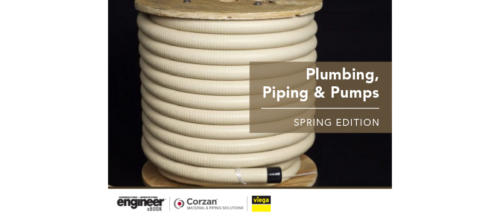Engineering workable, successful office space
Whether new or retrofit, office buildings can be a challenge for the mechanical, electrical, plumbing (MEP), or fire protection engineer. A team of experienced professionals offers advice on what to expect, and how to come out on top.
Respondents
- Julianne Laue, PE, LEED AP, BEMP,Senior MEP Engineer, Center for Sustainable Energy Mortenson Construction, Minneapolis
- Tony McGuire, PE, FASHRAE, Founder, McGuire Engineers Inc., Chicago
- Nathan Snydacker, PE, LEED AP, Vice President, ESD Global, Chicago
CSE: Please describe a recent office project you’ve worked on—share details about the project, including building location, size, etc.
Tony McGuire: Among recent office building projects have been the following: conversion of the 30-plus-year-old former Kraft Foods headquarters into new headquarters for Illinois Tool Works (ITW). The building is located in Glenview, Ill., and is approximately 550,000 sq ft; tenant occupancies in the historic Wrigley Building in Chicago; Parkway North, which is an office building complex of multiple buildings in the size range of 120,000 to 180,000 sq ft (the location is suburban Chicago); and retrofit of a 120,000-sq-ft 4-story warehouse into a U.S. Green Building Council LEED Platinum owner-occupied office building in Chicago.
Nathan Snydacker: As a leader within our workplace solutions group at ESD, my focus is primarily on commercial interiors and renovation projects. We work with a number of exceptional clients on a national and international basis, but the CBRE Chicago office relocation to 321 N. Clark and the Hillshire Brands HQ at 400 S. Jefferson in Chicago are two recent projects that provide great examples of recent trends in office space design. Both are multiple-floor projects implementing an open ceiling, loft-type design with a focus on open workstations and collaboration stations.
CSE: How have the characteristics of such projects changed in recent years, and what should engineers expect to see in the next 2 to 3 years?
McGuire: Characteristics of office buildings in our region have been shifting toward levels of scope design with design professionals providing oversight. As in most of America, the sustainable design concept still sells. We find fewer private developers looking for LEED buildings because they can accomplish the same results without the added costs of documentation.
Snydacker: In general, we are seeing the associated costs of mechanical, electrical, and plumbing (MEP) and technology systems becoming an increasingly larger percentage of the overall project costs compared to in the past. This is due to integrated technology such as lighting controls, wireless networks, and audio visual systems. Even as the economy improves over the next few years and project budgets become less restricted, the percentage of MEP and technology costs will likely continue to drive a higher portion of total costs.
CSE: Please describe any experience you have using sustainable heating/cooling technology, such as geothermal systems or ground source heat pumps.
Julianne Laue: For the Wisconsin Institute for Discovery: In an effort to build a U.S. Green Building Council LEED Silver Certified facility, the team incorporated a variety of sustainable elements into the building’s construction. Most notable is the team’s development and construction of a ground source heat pump system. To take advantage of this, the team drilled 75 bore holes, 300 ft deep below the site to capture the geothermal energy of the earth. Using geothermal power is expected to be so efficient that it will cut projected energy use of the facility by 10% annually. The system is expected to function for at least 50 years and will provide 3.6 million BTUs of heating and cooling capacity. Additional sustainable features include rooftop solar panels, energy-efficient mechanical systems, heat-recovery system for laboratory exhaust, triple-pane glazing, ground water recovery system for multiple uses including irrigation of interior planting, a night flush system to cool the building during summer months, intelligent building architecture with system monitors for all energy and utility usage, automatic shades to adjust to outside light levels, and exterior walls commissioned as a high-performance terra-cotta rain screen system that includes recycled insulation. The project was 330,000 sq ft and cost $213 million.
McGuire: We have used ground source heat pumps on only two projects we designed. However, we have performed consulting on six or seven projects which malfunctioned. Several of these could not reach temperatures above 60 F until 11 a.m. on Monday mornings during January/February cold spells.
Snydacker: We are currently implementing a geothermal system for Chicago Botanic Gardens using an adjacent lake as a heat sink for the cooling systems serving the building.
CSE: Please share a success story in which you were able to deliver a highly sustainable project to an office structure client.
Snydacker: Retro-commissioning is one way that we are able to help our office space and building owner clients optimize their system operations and reduce energy usage. A great example is the Hyatt Center at 71 S. Wacker in Chicago. Through a combination of implementing revised operation sequences and functional testing as part of our retro-commissioning services, we were able to help this building achieve a reduction of over 1.6 million kWh in annual electricity consumption.
McGuire: A 120,000-sq-ft LEED Platinum building we completed a few years ago has functioned as well as we imagined. The owner maintains it very well with in-house staff and has instituted biannual recommissioning in its budgets.
CSE: What are the newest trends in tenant retrofit projects?
Snydacker: We are seeing a tremendous amount of projects focused on collaborative environments coupled with workstation densification and a departure from private offices. Many of the projects we are working on are implementing an open ceiling design for a loft-type aesthetic.
McGuire: We design several million sq ft of office tenant spaces annually. Many projects are moving toward less footage of hung ceilings and more space for team concept areas. We see fewer private offices while incorporating higher technology features.
CSE: What are some challenges you have faced in coordinating structural systems with mechanical, electrical, plumbing, or fire protection systems?
McGuire: Mechanical work is always a source of special concern. Fewer ceilings require more sensitivity to acoustics. New building designs keep moving toward lower floor-to-floor heights.
Snydacker: Unfortunately, I have never met an architect that strives for the lowest ceiling height possible in his or her aesthetic vision. As such, coordination of MEP/fire protection (FP) systems with structure is always a challenge. Where we have plenum spaces, they are constantly restricted and ductwork, piping, conduit, etc., are often shoehorned into place. Even with an open ceiling concept, coordination of MEP items with structure can become more difficult as the runs need to be neat and orderly—elbows, flattened fittings, and inconsistent elevations become undesirable not only from a functional perspective, but also from an aesthetic perspective.
CSE: Describe any recent office development projects that include residential, commercial, retail, cultural, or a mixture of building types. Describe their challenges and benefits.
McGuire: We find many buildings with multiple types of occupancies. These can be commercial combined with residential as well as parking facilities. Fire separations are critical and often difficult to achieve. The benefits of such designs are the creation of communities within small interactive spaces. Downtown urban living has become very popular with the millennial generation. We see this as a growing trend.
CSE: When dealing with space constraints (tight floor-to-floor conditions), what tips or tricks can you offer to other engineers? What type of clash detection systems or software do you use to help avoid problems?
Snydacker: Utilizing Autodesk Revit and Navisworks for clash detection has improved our design efficiency while also helping to aid in coordination. Tight floor-to-floor conditions require additional coordination among the entire design team. Regular face-to-face meetings help sort out trouble areas and allow for all parties to collaborate on solutions. An ESD blog details the challenges and solutions derived on our Hillshire Brands project through use of Revit and coordination with the full design team.
McGuire: Tight floor-to-floor conditions can be an opportunity for creative engineering. Not too many years ago, we helped convert an apartment building with 9-ft floor-to-floor heights into an office building by using perimeter induction units.
CSE: Because office buildings must often be flexible (tenants change, space use changes), what are some best practices?
McGuire: Flexibility of office buildings is important, and we are very concerned that today’s new buildings will be difficult to change 20 years from now due to present energy and sustainability code language. That results in limited flexibility in capacities of infrastructure.
Snydacker: We tend to allow for diversity assumptions in our designs to provide better flexibility for future space modifications or usage. A methodical approach to air distribution, power distribution, and circuiting can alleviate many headaches when 3 years into a lease a client decides either to look at densification or possibly subleases part of its space to a tenant with much different office space usage.
CSE: What types of medical or health care offices have you worked on recently? Describe the challenges and solutions.
Snydacker: With many hospitals opening outpatient care facilities, we are seeing an increase in imaging suite projects. Often these imaging suites are going into office buildings, which may not have the power/cooling capacities available within existing infrastructure to support MRI equipment. Coordinating new electrical services and supplemental cooling systems is typically necessary.
McGuire: We have designed a number of outpatient care facilities. The difficult ones have been the speculative multi-tenant projects. Mechanical and electrical infrastructure will vary widely if tenants vary in their practices.
CSE: How do you see the design approach for office buildings changing in the next 2 to 5 years?
McGuire: We are seeing more and more adaptive reuse type projects as opposed to new speculative office buildings. Tenant needs are increasing, but they are being served with a large inventory of vacant space available. We also see corporate cultures moving toward spaces with more modest accoutrements.
Snydacker: I anticipate that we will see more integrated technology built into core and shell or base buildings: distributed antenna systems (DAS), fiber-optic backbones, hubs for “meet me rooms”/fiber exchange centers for multiple carriers to provide services and allow tenants better connectivity to co-location (colo), cloud storage, and satellite offices. From an interiors standpoint, I anticipate that the pendulum will eventually swing away from dense open office space and back toward a balance between open and private offices.
Do you have experience and expertise with the topics mentioned in this content? You should consider contributing to our CFE Media editorial team and getting the recognition you and your company deserve. Click here to start this process.




